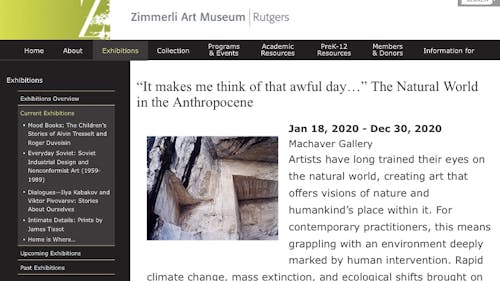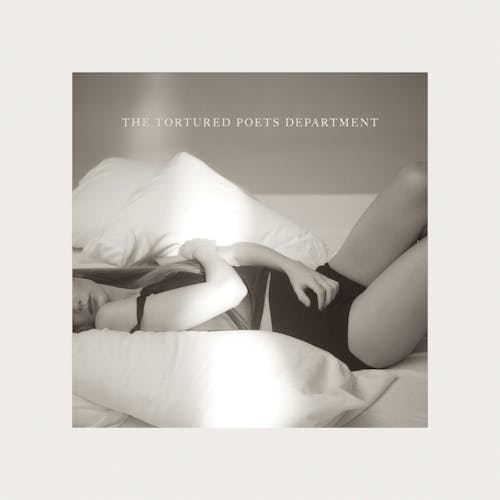Zimmerli Art Museum hosts 'Art Before/After Hours,' honoring Anthropocene

On Tuesday, the Zimmerli Art Museum, in collaboration with Rutgers Global, hosted the first Art Before/After Hours of the academic year, centered around “It makes me think of that awful day…” The Natural World in the Anthropocene. The exhibition opened earlier this year in the Zimmerli’s Machaver Gallery and draws light on the impact of humanity on the natural environment, through the lens of contemporary art.
The event took place in the morning from 9 a.m. to 10 a.m. and from 7 p.m. to 8 p.m. in order to accommodate the needs of the Rutgers community currently spread throughout the globe.
As an international student who loves frequently attending the Zimmerli’s usual Art After Hours events, this flexibility in timing is something I truly treasure when faced with a significant time difference. While I miss the physical space of the Zimmerli, with its high ceilings and often labyrinth-like structure, events like these bring the museum a little close to home.
The event was moderated by Amanda Potter, curator of Education and Interpretation, with introductory remarks by the museum’s Interim Director and Curator of Modern and Contemporary Art Donna Gustafson and the Director of Rutgers Global—Programs and Partnerships Rick Lee.
The exhibition is organized by the Zimmerli’s Andrew W. Mellon post-graduate intern Austin Losada and graduate curatorial assistant Hannah Shaw. Art Before Hours began with a brief but comprehensive video tour of the exhibition put together by Losada and Rutgers Global’s digital media assistant Conor Risi.
In order to better understand the art in the exhibition, it is useful to first ponder over what the complex term “Anthropocene” means. "The Anthropocene Epoch is an unofficial unit of geologic time, used to describe the most recent period in Earth’s history when human activity started to have a significant impact on the planet’s climate and ecosystems,” according to National Geographic.
The name of the exhibition comes from Walton Ford’s 2011 print “It Makes Me Think of that Awful Day on the Island,” which depicts King Kong with tears streaming down his face as he reminisces on the loss of his habitat, and by extension, his life.
This empathetic rendering of King Kong is different from people’s perceptions of the tough, roaring and chest-pounding gorilla many of us remember from the silver screen. Another melancholic depiction of a natural being that was created in 2011 is Alexis Rockman’s “Iguaca,” a print that honors the endangered Puerto Rican parrot of the same name.
The exhibition also includes massive sculptural works that explore the materiality of the earth using synthetic materials through their site-specific engagement, such as the Boyle Family’s “Cobbles Study with tire tracks, earth, stones and glass from the Lorrypark Series” (1976) and Robert Lobe’s “Angel” (1988).
While the former allows one to see how non-biodegradable materials get pressed into the earth and become integrated into the natural world, the latter recontextualizes the body of a tree using manmade materials and the metalworking technique of repoussé.
One of the most stunning pieces in the exhibition is Diane Burko’s oil on canvas “Petermann Calving, August 16, 2010, (After NASA),” which is based on satellite imagery of a 2010 climate event in the Petermann Glacier in North-West Greenland.
The mesmerizing blends of blue, white and gray mix in the eye and almost make one forget the cataclysmic qualities of rising temperatures on vital glacial environments that are melting at alarming rates.
Edward Burtynsky’s “Carrara Marble Quarries #21, Carrara, Italy” (1993) is the only photograph in the exhibition and reveals the fascinating geometry and aesthetic texture of marble quarries that were used by sculptors during the Renaissance. This same marble is still being extracted and utilized for a different form of artistic production, designing people’s homes.
Eco artist Christy Rupp has two sculptures featured in the exhibition, “Spill” (1992) and “Turtle Skeleton” (1998), which unveil the sinister truth behind human economic interests and activities by touching on subjects such as the detrimental effects of oil drilling.
After the video tour, Dr. Mary Nucci, an assistant research professor in the Department of Human Ecology with an interest in science communication, reflected on why art was critical in contextualizing the Anthropocene and the science behind it.
In her interdisciplinary presentation, she discussed how images are polysemic and help visualize scientific data, which in turn shapes human perspectives and the way we process information. When given visual evidence of human effects of the environment, events in the Anthropocene become more real and local, less distant and hold us accountable.
Art is more than just documentary when applied to the field of science — it serves as a form of experiential learning, and sparks change by inspiring people to look inward and contemplate how they can leave the world better than they found it. Dr. Nucci’s words helped bridge the gap that many people commonly believe exists between science and art.
The event ended with a brief question-and-answer session with Dr. Nucci, Shaw and Losada, and was moderated by Potter. Attendees were encouraged to take away what they learned at the event and enter a Creative Challenge, which closes on Oct. 13, where they create a “Monument for the Anthropocene.”



